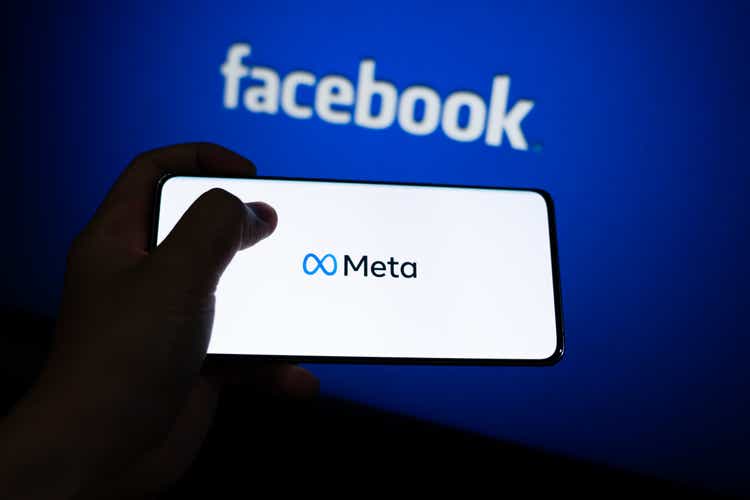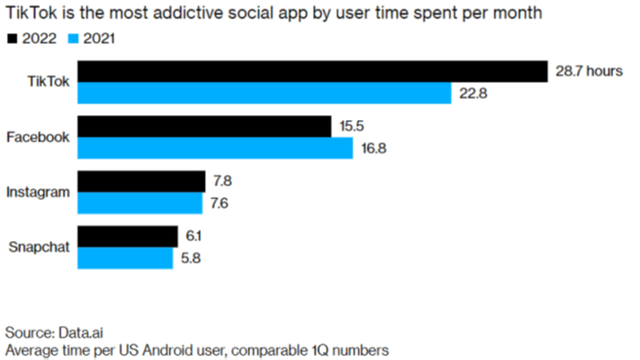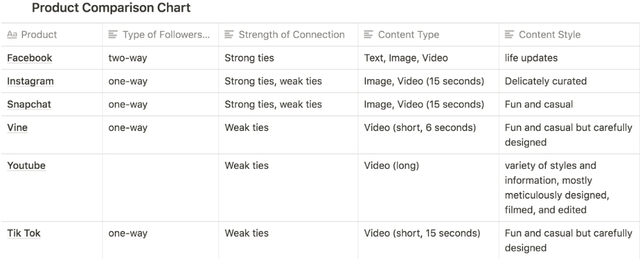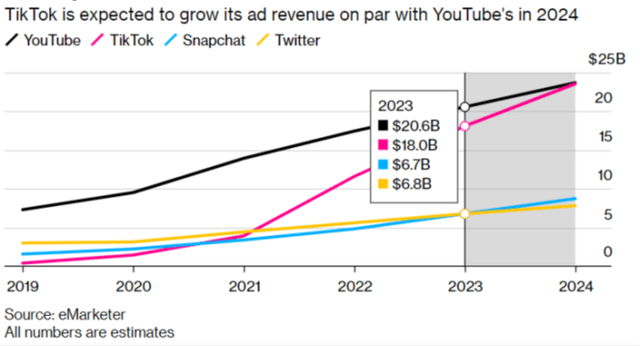Fritz Jorgensen
Meta Platforms – Tick Tock, Tick Tock
A few years ago, a credible challenge was considered too distant for a business that thrived on its ability to accurately profile its users based on their likes and shares. The amount of data the company collected, distilled and processed for optimal user feed and ad placement was presumed to be an insurmountable challenge. After all, who would have thought a serious competition against a behemoth that proclaimed more than a billion users having provided enough information to help the company tie them up even for more active minutes. However, the following chart shows a different picture today.

Bloomberg.com
Is TikTok Threat To Meta Platforms Overblown?
TikTok has radically changed the social media landscape as every other business (not just social media), competing for user attention, is scrambling to adjust its product offering. The short-form video content making and sharing platform has a come a long way since it was first released for Android and iOS platforms in 2017 by ByteDance.
The app has been downloaded more than 3.3 billion times across various platforms including desktop, mobile and tablets. This is despite a ban by India that was imposed in January 2021, which probably slowed down the user growth, otherwise set up for a much faster growth in user base. The app had over 200 million users from India before the ban by the Ministry of Information Technology.
The app is more popular among the younger people with 63% of users being less than 29 years of age. The key success factors for TikTok are its easy-to-navigate interface and the user’s ability to access entertainment videos of short duration. Apart from the fun stuff, the users have taken the platform as one of their key tools in citizen journalism.
The threat has been well acknowledged by all the industry players as they launched similar services copying TikTok’s short-form video offering. YouTube even established a US$100m fund to encourage the content creators to share the most engaging clips on its Shorts platform that was softly launched in the fall of 2020. Facebook launched its Instagram Reels feature in August 2020 that offers the same functionality to short-form video creators.
What Has TikTok Done Differently?
The app seems to have successfully persuaded a large number of (especially young) people to actually pick up the phone and create content for the platform that is highly entertaining. The other platforms like Facebook, YouTube, Twitter, Snapchat offered similar kind of product features, however the brand activation for aspiring performers has been done exceptionally well by TikTok.
TikTok has clearly democratized the content and managed to hook the content creators through initiatives like TikTok challenges, promoting relevant hashtags, duets, mimicking a popular video to gain viewer traction, easier upload mechanism, and different filters. Combining this with the human desire to record and/or see oneself performing to the popular music or funny content or daring challenges precipitates the creation of content that is highly addictive for the viewers along horizontal (different topics) as well as vertical (different creators on the same topic) dimensions.
The higher average time spent by the users has allowed TikTok a commanding position in the advertising space as it now charges US$2.6m per day, approximately 4x what it did last year, for the top ads to be run on the platform.
A Two-Way Platform
The app works for its users from both dimensions; one for content creators and the other for content consumers.
For content creators, it allows them to gain more recognition and followers with an easy-to-use app interface so they can record themselves or important newsworthy content even with limited financial and technical resources. In short, TikTok lets anyone become a star!
For content viewers, it helps them escape reality through entertaining visuals from a large global content pool that is reasonably aligned with their personal interests.
The integration of these two jobs creates a rabbit hole that is very hard to escape, especially for the younger generation (below 25) who are yet to fully develop their brain’s pre-frontal cortex that governs the impulsive decision making.
Discovery Engine
Although Facebook’s Discovery Engine is presumed to be quite powerful, it seems the TikTok app is better able to reduce the number of unwanted videos to be displayed, hence the motivation to leave the app goes down significantly. Since the videos are short-duration, the attention keeps shifting from one video to the other but the content never becomes boring enough to exit the session. This results in ever increasing number of hours spent watching the videos and during the process, providing more data points to analyse and work with to optimize the feed even further.
Organic & Inorganic Adaptation
As the app continues to significantly grow based on all performance metrics, the management has not lost sight of required adaption. The company is testing its interactive gaming platform in a smaller market in partnership with major gaming provider. This would attract new customers who are more interested in gaming and also tap its large existing user base to provide them with additional reasons to spend time on the app. It targets non-consumption of the gamers and aims to bring them on board as gaming hours can add considerably to the already high average time spent on the app. The introduction of gaming, music distribution, twitch subscription, and TikTok Live are all measures in that direction.
In addition, it empowers the users to create various challenges which keep generating additional views. This exponentially increases the retention power of the app unlike any other social media or streaming platform.
What’s Next?
TikTok is so far taking all the right steps to grow and engage the customer base better than the other social media platforms have been able to. The users can view the content not just from their network but also beyond that and any geographical limits. This has significantly lowered the barriers to entry for the content providers (or performers) globally, which means the content pool will only grow from here. The app is already challenging the incumbents despite its recent arrival on the scene with expectation to close the revenue gap with its biggest rival YouTube by 2024.
The app competes not just with the streaming services like Amazon Prime, YouTube, Netflix, Disney+, but also aims to take user’s attention away from Facebook, Twitter, Snapchat where people are mostly connected to their friends and family. The places like theatres, concert arenas, parks, roads, transport systems, restaurants and headline news events have become key enabling avenues for the TikTok content creators. It seems like the app has overcome the challenge from incumbents and is headed to achieve the top spot relatively soon.
The initiative by various platforms on the Metaverse, may cause some serious challenge to TikTok but one may argue if the technological advances would affordable enough in time to entice a large customer base away from TikTok. After all, the Apple self-driving car is a venture being pursued since 2014 but the launch is scheduled not before 2025-2027. The saturation in the influencer pool might come soon and the discovery engine could get overwhelmed with the ever increasing data points, but till then, the app will keep its competitors on their toes, continuing to eat their lunch view-by-view, ad-by-ad.




Be the first to comment